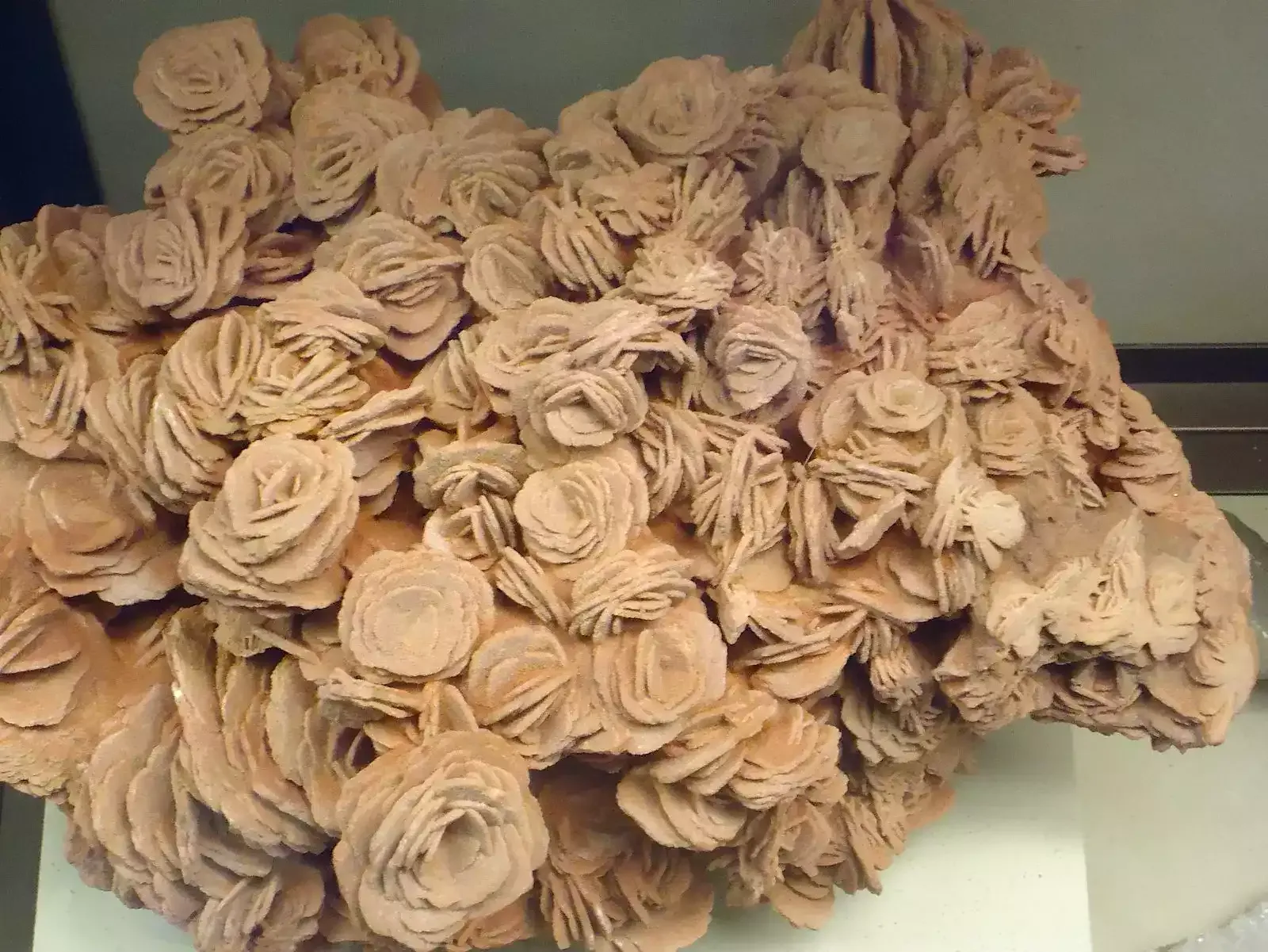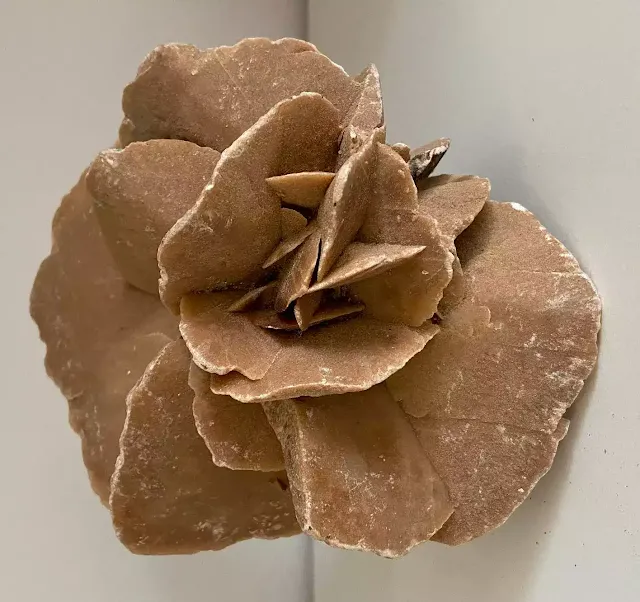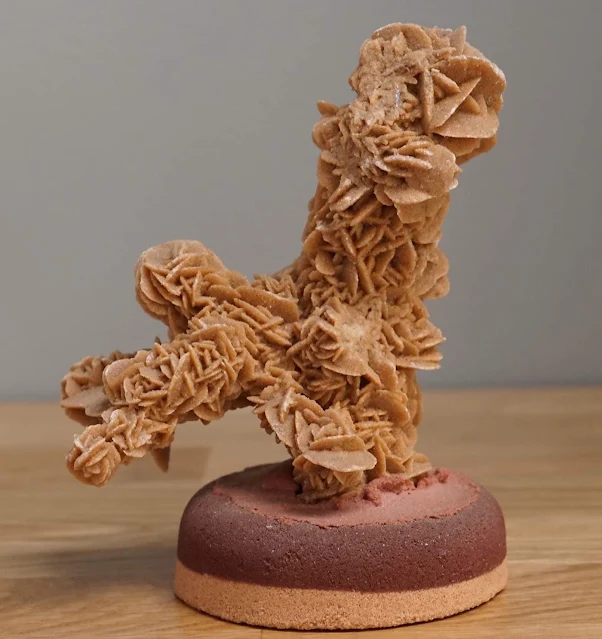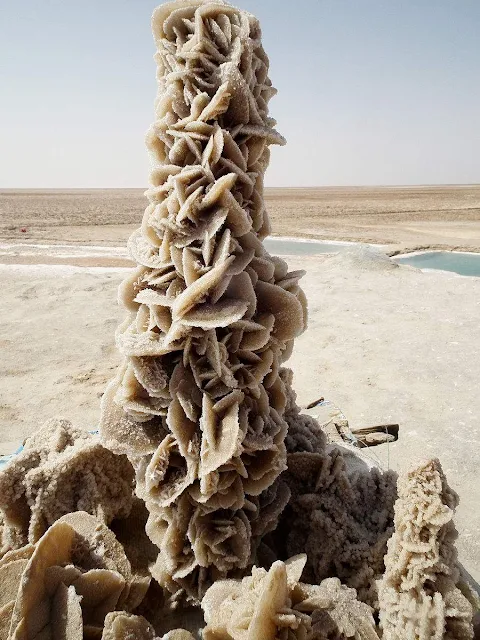Sahara Desert Rose
Sahara Desert Rose, also known as a gypsum rose or sand rose, is a fascinating natural formation found in arid regions, particularly in the Sahara Desert in North Africa, particularly in Algeria, Tunisia, and Libya. It's not actually a rose, but rather a cluster of crystals that resemble the delicate petals of a rose.
The term "Sahara Desert Rose" typically refers to a specific type of mineral formation rather than an actual plant or flower.
Sahara Desert Roses are composed of gypsum or baryte, both of which are minerals that form in arid environments. The sand grains that are embedded within the crystals give them their characteristic rose-like shape.
 |
| Sahara Desert Rose |
How are Sahara Desert Roses Formed?
The formation of Sahara Desert Roses is a complex process that involves the evaporation of water in arid environments.
In arid environments, shallow basins containing dissolved minerals (e.g., gypsum, baryte) experience rapid water evaporation. This concentrates the mineral solutes within the remaining water.
Crystallization: Upon reaching supersaturation, the concentrated minerals precipitate and crystallize. These crystals typically adopt a tabular habit, forming thin, blade-like structures.
Sand Inclusion: Aeolian sand transport within the basin leads to the incorporation of sand grains into the crystallizing mineral matrix.
Radial Growth: The crystals exhibit preferential growth along specific crystallographic axes, resulting in a radial outward expansion. Sand grains become trapped within the growing crystal lattice, contributing to the characteristic rosette morphology.
Color Variation: Impurities and trace elements incorporated during crystallization determine the final color of the Desert Rose. Iron oxides, for example, contribute to red and brown hues.
 |
| Desert Rose from Tunisia |
What Do Sahara Desert Roses Look Like?
The most defining feature is the rosette-shaped structure, resembling the petals of a flower. This arises from the radial growth of flat, tabular crystals around a central point.
The shape can vary from tightly packed, circular rosettes to clusters with more spread-out "petals." Some formations even resemble miniature roses with distinct "stems" and "buds."
Desert Roses can range in size from small, pebble-sized formations to large, multi-pound clusters. The size depends on various factors like the duration of crystal growth and the availability of mineral resources.
Color
Diverse Palette: The color of Desert Roses is influenced by impurities trapped within the crystal lattice during their formation. This can result in a wide range of hues, including:
- White: Pure gypsum crystals often appear white or translucent.
- Red and Brown: Iron oxides contribute to various shades of red and brown.
- Black: Impurities like manganese can create dark, almost black Desert Roses.
- Other Colors: Less common colors like yellow, green, and even blue can occur due to specific minerals present.
Are Sahara Desert Roses Rare?
While Sahara Desert Roses are not extremely rare, their unique and intricate formations make them highly sought after by mineral enthusiasts and collectors. The specific conditions required for their formation contribute to their relative scarcity in certain regions.
 |
| Desert rose (crystal) from Algeria |
Where are Sahara Desert Roses Found?
Sahara Desert Roses are associated with desert regions, particularly the Sahara Desert in North Africa. South-West Tunisia: The most prominent deposits are found near the Chott el Djerid, a large salt lake. This region boasts particularly high-quality Desert Roses due to the high salt content, enhancing their crystal structure and luminosity.
Neighboring Regions: Adjacent areas in Algeria and Ghadames, Libya, also share similar geological conditions and yield notable Desert Rose formations.
Can Sahara Desert Roses be Found Anywhere Besides the Sahara?
While the Sahara Desert is the most well-known location for finding Sahara Desert Roses, these fascinating formations can actually be found in other arid regions around the world!
Namib Desert: The Namib Desert of southern Africa is known for its unique "sand roses," often smaller and more fragile than their Saharan counterparts.
Saudi Arabia: The Abqaiq region of Saudi Arabia boasts red-hued Desert Roses formed from gypsum and iron oxides.
Mexico: The Chihuahuan Desert in northern Mexico, characterized by its hot, dry climate, harbors pockets of Desert Roses.
United States: The southwestern United States, especially Death Valley and the Mojave Desert, also provide suitable environments for Desert Rose formation.
 |
| Tunisia desert rose |
What are the uses of Sahara Desert Roses?
While Sahara Desert Roses, with their captivating flower-like shapes, are naturally stunning, their uses extend far beyond mere aesthetics. Here's a glimpse into the diverse applications of these fascinating geological formations:
Home Decor: Their unique beauty makes them popular additions to homes, offices, and gardens, adding a touch of natural elegance and conversation-starting intrigue.
Museum Specimens: Particularly well-formed or rare examples find their place in museums and private collections, serving as valuable specimens for geological study and appreciation.
Metaphysical and Spiritual Practices: In some cultures and belief systems, Sahara Desert Roses are associated with metaphysical and spiritual properties. They are believed to have protective qualities, bringing positive energy and luck. Some individuals use them in meditation or for spiritual grounding.
Educational Purposes: Sahara Desert Roses play a role in educational settings, especially in geology and mineralogy courses. Their unique crystal structures and the geological processes that lead to their formation provide valuable learning opportunities for students studying Earth sciences.
Artistic Creations: Artists and craftsmen sometimes incorporate Sahara Desert Roses into their creations. The intricate patterns and shapes of these formations can inspire unique artistic designs in sculptures, paintings, and other artworks.
Symbolism: In some cultures, Desert Roses symbolize abundance, prosperity, and fertility due to their resemblance to blooming flowers.
Souvenirs: They are popular souvenirs for tourists visiting regions where they are found, supporting local economies and cultural traditions.
Can Sahara Desert Roses be purchased or collected?
Yes, Sahara Desert Roses are available for purchase from mineral dealers and specialty stores. They are also commonly collected by enthusiasts and hobbyists interested in mineralogy and geology.
Conclusion
In conclusion, Sahara Desert Roses stand as geological poetry etched in
gypsum, a harmonious collaboration between Earth's elements and the
passage of time. As we admire these natural sculptures, we are reminded
that even in the harshest environments, beauty persists, waiting to be
uncovered by those willing to explore the wonders hidden beneath the
desert sands.
Read also: Desert Rose: Types, and Where Are Desert Roses Found
The Crystal Mountain in Egypt (Photos)
Libyan Desert Glass: Formation, Properties, Where to Find it

%20(1).webp)






